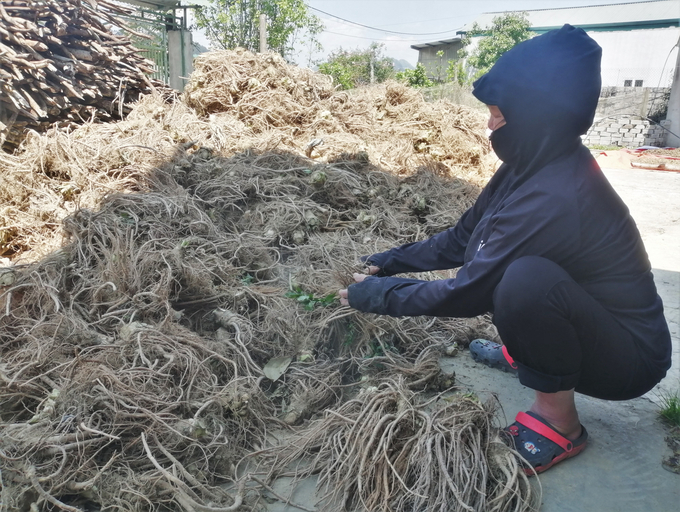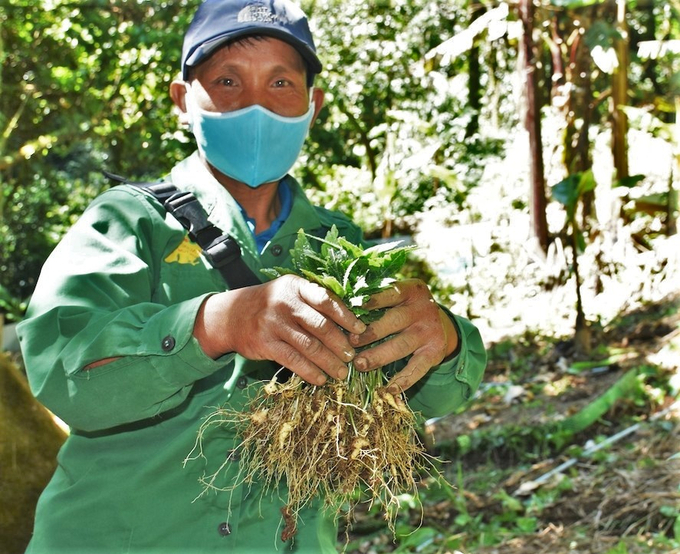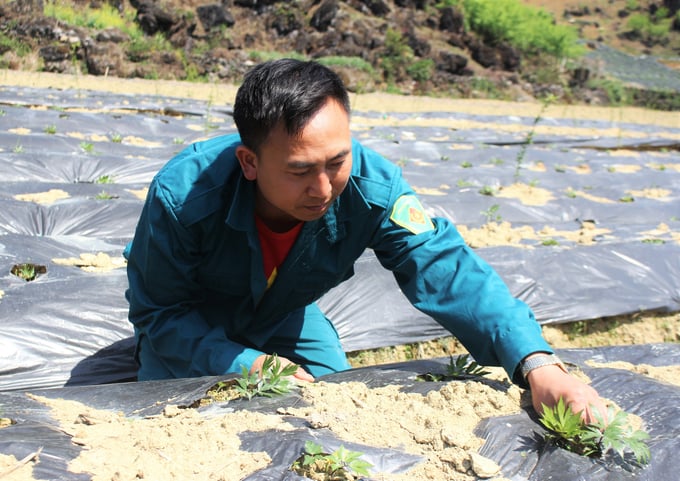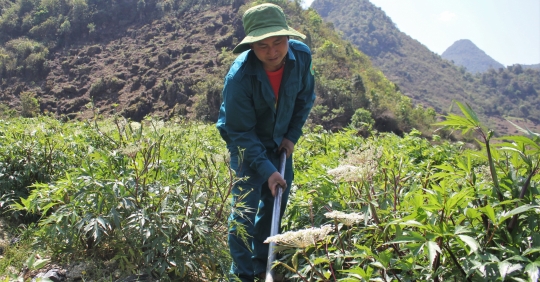[ad_1]
LAI CHAU People in the border community of Sa De Phin said medicinal plants are not only used as medicine to save lives, but also help cure “poor diseases” for people in the community.
Food and possessions that even medicinal plants depend on
Sin Ho is a border district in the highlands of Lai Chau Province with an average elevation of about 1,500 m above sea level. The climate of the Sin Ho district is typical of the north-western high mountain tropics, which is favorable for the development of medicinal plants. This place belongs to one of the eight major medicinal regions of Vietnam (according to the Prime Minister’s Resolution No. 1976/QD-TTg of October 30, 2013, which approves the master plan for the development of medicinal herbs by 2020 and defines them by 2030).
In the memory of many, the 80s of the last century saw the heyday of medicinal herbs here. Sin Ho used to be one of the country’s greatest medicinal plants. The medicinal herbs here are said to have a higher medicinal effect than in other places. The production, harvest and trade of medicinal herbs are busy day and night.

People in Sa De Phin commune provisionally process dong quai after harvest. Picture: Lighthouse.
When the medicinal herb farm was liquidated, Bao Long Pharmaceutical Group continued to invest in the development of the medicinal field with the aim of making it a center for supplying medicinal materials for the group. But then the project was unfinished for many reasons.
The failed major projects have left a great disappointment for the people of Sin Ho. However, through a long journey of connectedness, medicinal herbs have become a trusted companion on the path to eradicating hunger, reducing poverty, and achieving prosperity.
Sa De Phin commune is considered to be the cradle of medicine in Sin Ho district. In the words of Mr. Giang A Tung, chairman of the commune people’s committee, medicinal plants are not only used as medicine to save lives, but also help “poor diseases ” to heal for the people in the commune.
Mr. Tung said, Sa De Phin is a border town in the highlands and as such faces many difficulties. The terrain is highly fragmented, steep slopes, agricultural land is limited, arable land is far from residential areas, lack of water for production… The township has 4 villages with 452 households, 2,249 employees, export, where Mong ethnic group make people more than 80% off. The total number of poor households is 265 households (58.62%), the number of households close to poverty is 50 households (11.06%) away from people’s lives.

Medicinal plants have gradually contributed to eradicating poverty from the lives of the mountain dwellers. Picture: Lighthouse.
“Food crops are only enough to meet basic needs, small-scale animal husbandry, and selling prices are now low, so people’s income now depends on medicinal plants. The income from medicinal herbs helps people step by step to have food and property and to have conditions to improve their material and spiritual life,” Tung affirmed the irreplaceable place of medicinal plants in the lives of the people of this mountainous region.
From pure exploitation in the wild, many households have learned the technique and bravely bought seeds to plant in the forest, upland and even in their family’s garden. Also, the gardens of ginseng dong quai, artichoke… gradually grew. From the originally small area, the whole community now has about 20 hectares of Duong Quy Ginseng and over 8 hectares of artichokes. Other medicinal herbs such as tofu, sandalwood ginseng, floral septum, lai chau ginseng… are also grown scattered throughout the villages of the commune.
Manufactured medicinal herbs, absolutely no tricks
Wherever medicinal plants go, the lives of people in the communities of Sin Ho district are thriving. Fresh dong quai costs between 25,000 – 100,000 VND/kg (depending on the variety), dried dong quai costs 150,000 – 200,000 VND/kg; Artichokes average about VND 50,000/tree…has helped ethnic minorities earn a large income to improve their lives.
More importantly, people’s perceptions are gradually changing. They love the country, love the forest more than ever. Because everyone understands that medicinal plants only have a habitat and people find support through the protection of land and forests.
Mr. Mua A Minh, head of Sang Phin Village (Sa De Phin Township) confided that the demand for purchasing medical supplies from pharmaceutical companies, traditional medicine shops, etc. is very high at present. However, your requirements for the quality of raw materials are not easy. In order not to miss the opportunity to change their lives, people urged each other to protect every medicinal plant.

According to Mr. Giang Xuan Cuong, director of My Dao Cooperative, for the successful cultivation of organic medicinal herbs, all stages of the production process must be strictly controlled according to the organic production process. Picture: Lighthouse.
Areas on which medicinal herbs are grown are given priority, no mixed cultures with other cultures. Saying an absolute “no” to pesticides in particular. The areas under cultivation of other crops around the medicinal plant area also limit the use of pesticides; In case of application, measures must be taken to prevent the spread of medicinal herbs.
“Mothers, mothers in the village now care more about medicinal plants than their husbands! But don’t be sad because if you neglect to let medicinal herbs degrade, merchants won’t buy them, families don’t have money to spend and medicinal herbs can’t be eaten instead of rice,” said village chief Mua Ein Minh happily.
The movement to produce safe medicinal herbs was like a great wave that gradually spread to every village. The big ideas come closer together step by step, so that the production groups, pharmaceutical cooperatives, are formed from them.
Through cooperatives, the Mong and Dao people can progress from “elementary school lessons” on soil improvement techniques, breeding and cultivation of medicinal herbs to advanced knowledge of production compounds and organic medicinal herbs. This city is a case in point.
Mr. Giang Xuan Cuong, director of the cooperative proudly said: When households were initially mobilized to join the cooperative, nobody would believe it because the planting technique used by the cooperative was completely different from the ingrained farming practices and habits through generations of people . Although the capital is small, the cooperative still tries to invest 100% of each household’s expenses, if the harvest is successful, the new households believe in following it.
After a period of hard work, the cooperative has now gathered 10 members with a total area of 10 hectares of medicinal plants (mainly ginseng dong quai). In addition, cooperatives are developing links with dozens of households in villages and hamlets.
Mr. Cuong revealed that of course the business has tricks, but it is absolutely impossible to produce medicinal herbs. Simply because herbs are drugs, but if they are drugs, not even a single cup of medicine can be wrong. Therefore, in order to produce products of the best quality, every step in the production process must comply with the standard.
The cooperative has asked its members and affiliated households to agree to use the same cultivation method. Prior to sowing, the malls, along with the cooperative, will take soil samples to test for levels of toxic chemicals, pesticide residues, etc. to ensure the new standards are planted.
In order for medicinal herbs to grow and develop well, for high productivity, the work of improving and adding nutrients to the soil must also be worked out. Because on a maximum land area, medicinal herbs can only be grown for 3 years in a row, while it is not possible to use drugs to stimulate or grow.
However, how to refill the soil without chemical residue is another problem. Mr. Cuong had to go all the way down to Vinh Phuc, find livestock farms to order them to provide the cooperative with manure composted with probiotics that can be used immediately after purchase. When fertilizer became available, he mobilized his manpower to distribute it evenly over the field, used a plow to till the same soil, and then proceeded to plant furrows.

Growing safe and organic medicinal herbs helps Sin Ho residents’ products to be easily consumed at high prices. Picture: Lighthouse.
In addition, the seedling is also changed. Instead of self-propagating as before, the cooperative commissioned the Vietnam Agricultural Academy to provide quality seedlings. The grooming process is operated entirely by human hands.
“Doing this manually is not very profitable, but it preserves the medicinal properties of the plant. The pharmacies they make are very strict about humidity, for example, if they ask for 10%, they just don’t take 10.1%,” said Mr. Cuong.
Thanks to this approach, consuming My Dao Cooperative products will also be convenient. Products manufactured everywhere are all bought from male pharmacies, pharmaceutical companies… On average, the cooperative puts around 40 tons of fresh medicinal herbs on the market every year. In addition, the cooperative invested more than VND 1 billion to build a medicinal herb drying kiln with a capacity of 5 tons/batch to provide dried products.
In addition, the cooperative has also developed a range of products deeply processed from medicinal herbs, such as and achieved 3-star OCOP. The members of the cooperative now have an income of 7-15 million VND/month just from the provision of each meal.
Ms. Quang Thi Hoa, a member of the My Dao Cooperative, did the math: In the same area, household income from cultivating medicinal herbs is 30-40 times higher than from cultivating rice up until now. Thanks to medicinal herbs, people no longer go hungry. Motorbikes, televisions, refrigerators… were also placed under each roof in turn. Children have conditions to go to school to learn. Many people have started thinking of the “sweet thing” by enriching themselves with these bitter harvests.
[ad_2]
Source link

